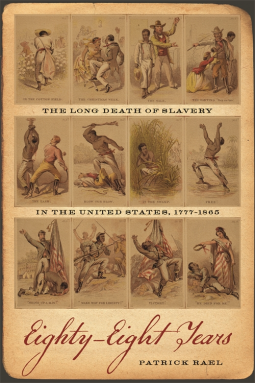Please wait... This may take a moment.
Eighty-Eight Years
The Long Death of Slavery in the United States, 1777–1865
This title was previously available on NetGalley and is now archived.
Pub Date
Aug 15 2015
| Archive Date
May 15 2015
Description
Why did it take so long to end slavery in the United States, and what did it mean that the nation existed eighty-eight years as a “house divided against itself,” as Abraham Lincoln put it? The decline of slavery throughout the Atlantic world was a protracted affair, says Patrick Rael, but no other nation endured anything like the United States. Here the process took from 1777, when Vermont wrote slavery out of its state constitution, to 1865, when the Thirteenth Amendment abolished slavery nationwide.
Rael immerses readers in the mix of social, geographic, economic, and political factors that shaped this unique American experience. He not only takes a far longer view of slavery’s demise than do those who date it to the rise of abolitionism in 1831, he also places it in a broader Atlantic context. We see how slavery ended variously by consent or force across time and place and how views on slavery evolved differently between the centers of European power and their colonial peripheries—some of which would become power centers themselves.
Rael shows how African Americans played the central role in ending slavery in the United States. Fueled by new Revolutionary ideals of self-rule and universal equality—and on their own or alongside abolitionists—both slaves and free blacks slowly turned American opinion against the slave interests in the South. Secession followed, and then began the national bloodbath that would demand slavery’s complete destruction.
Why did it take so long to end slavery in the United States, and what did it mean that the nation existed eighty-eight years as a “house divided against itself,” as Abraham Lincoln put it? The...
Description
Why did it take so long to end slavery in the United States, and what did it mean that the nation existed eighty-eight years as a “house divided against itself,” as Abraham Lincoln put it? The decline of slavery throughout the Atlantic world was a protracted affair, says Patrick Rael, but no other nation endured anything like the United States. Here the process took from 1777, when Vermont wrote slavery out of its state constitution, to 1865, when the Thirteenth Amendment abolished slavery nationwide.
Rael immerses readers in the mix of social, geographic, economic, and political factors that shaped this unique American experience. He not only takes a far longer view of slavery’s demise than do those who date it to the rise of abolitionism in 1831, he also places it in a broader Atlantic context. We see how slavery ended variously by consent or force across time and place and how views on slavery evolved differently between the centers of European power and their colonial peripheries—some of which would become power centers themselves.
Rael shows how African Americans played the central role in ending slavery in the United States. Fueled by new Revolutionary ideals of self-rule and universal equality—and on their own or alongside abolitionists—both slaves and free blacks slowly turned American opinion against the slave interests in the South. Secession followed, and then began the national bloodbath that would demand slavery’s complete destruction.
Advance Praise
“Patrick Rael’s elegant prose wisely tells this
narrative from a number of perspectives. Like all smart social
historians, Rael understands that power cannot be ignored, and
politicians on both sides of the Civil War are given voice in this
important work.”
—Douglas R. Egerton, author of Year of Meteors: Stephen Douglas, Abraham Lincoln, and the Election that Brought on the Civil War
"Rael examines the long, slow death of slavery in
the United States, masterfully showing how each event is connected and
letting us in on secrets that textbooks never mentioned. . . . Rael
enlightens us on the wide differences in slavery throughout the New
World and its ending through the Caribbean and Latin America, and he
effectively shows the difficulties of emancipation, reconstruction, and
the pervading white supremacy of the North. There are not enough
superlatives to describe the wealth of information in this book and the
bright, clear way in which it is taught. Just buy it."—Kirkus Reviews (starred review)
“Patrick Rael’s elegant prose wisely tells this narrative from a number of perspectives. Like all smart social historians, Rael understands that power cannot be ignored, and politicians on both...
Advance Praise
“Patrick Rael’s elegant prose wisely tells this
narrative from a number of perspectives. Like all smart social
historians, Rael understands that power cannot be ignored, and
politicians on both sides of the Civil War are given voice in this
important work.”
—Douglas R. Egerton, author of Year of Meteors: Stephen Douglas, Abraham Lincoln, and the Election that Brought on the Civil War
"Rael examines the long, slow death of slavery in
the United States, masterfully showing how each event is connected and
letting us in on secrets that textbooks never mentioned. . . . Rael
enlightens us on the wide differences in slavery throughout the New
World and its ending through the Caribbean and Latin America, and he
effectively shows the difficulties of emancipation, reconstruction, and
the pervading white supremacy of the North. There are not enough
superlatives to describe the wealth of information in this book and the
bright, clear way in which it is taught. Just buy it."—Kirkus Reviews (starred review)
Available Editions
| EDITION |
Other Format |
| ISBN |
9780820348391 |
| PRICE |
$32.95 (USD)
|
Additional Information
Available Editions
| EDITION |
Other Format |
| ISBN |
9780820348391 |
| PRICE |
$32.95 (USD)
|
Average rating from 6 members
Readers who liked this book also liked:





